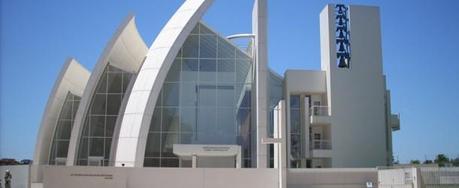


Smog-eating cement first made headlines back in 2007, when it was introduced in the U.S. by the Italian company Italcementi, whose R&D center is pictured top. The cement is called TX Active and the magic ingredient is titanium oxide. When exposed to sunlight, titanium oxide can neutralize some pollutants – basically the toxins are oxidized when they come into contact with the cement. For instance, nitrogen oxide and sulfur oxide gasses are made harmless when they are turned into nitrates or sulfates. Without the catalyst of titanium oxide, the nitrogen and sulfur oxide break down in the atmosphere creating smog and ground level ozone.
But with the catalyst, the nitrates and sulfates simply wash off with rainwater, leaving the cement very clean and without a need for chemical treatment. One of the more well-known examples of this self-cleaning cement is the Air France headquarters in Roissey-Charles de Gaulle airport in Paris. The HQ is housed in a very white building, that has remained through the years very white.
Originally the cement was made for Richard Meier, the architect who requested a very white cement for the Jubilee Church in Rome. It was only later that Italcementi noticed its pollution-killing quality. They had topped off a road in Bergamo with TX Active. The residents soon reported better-smelling air. Italcementi then began to market cement as an agent of change – turning over its typical rep as antienvironmental.
A study of busy roadways in the Netherlands found that photocatalytic concrete (the generic term) decreased nitrogen oxide levels by 25 to 45 percent. This is anywhere between 0.5 and 1.5 m above the road.
From a design perspective, anything that can be made out of concrete is a potential application. Beyond the ubiquitous sidewalks and roads there is a lot of potential for using this material in green architecture. According to the Environmental Protection Agency stats that 34% of nitrate oxides comes from vehicles on the road. Last Fall as a pilot project, a two-mile stretch of sidewalk in Chicago was paved with this same cement. West Cermak Street is a well-worn route for trucks, and is a particularly polluted area in the city.
